|
FOCUS / FORUM
INDEX
|
 |
In 2008, the Forum Comment,
was relaunched as the Focus
reflecting the closer comment from
NEMP and the panel of educators. |
 |
|
Main Index for Focus / Forum
Introduction
to Focus / Forum
He
Whakaputanga Whakaaro –
Introduction for Mäori
Medium forums
|
| Forums by year of assessment |
|
|
|
Science
Art
Graphs, Tables & Maps
|
|
|
|
Music
Aspects of Technology
Reading & Speaking |
|
|
|
Information
Skills
Social Studies
Mathematics |
|
 |
|
Listening
& Viewing
Health & Phys. Ed.
Writing |
|
| Forums for Mäori Medium |
|
|
|
Science
Art
Graphs, Tables & Maps
|
|
|
|
Music
Aspects of Technology
Reading & Speaking |
|
|
|
Information
Skills
Social Studies
Mathematics |
|
 |
|
Listening
& Viewing
Health & Phys. Ed.
Writing |
|
|
|
|
|
 |
|
|
|
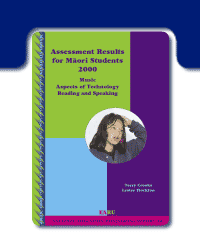
CLICK
on cover above for full 2000 report
|
|
|
I te tau 2000, i te wä tonu e mahia ana te kaupapa tätari
i te mätauranga i ngä kura katoa, ka mahia e NEMP
tëtahi kaupapa ä-motu e tätari ana i ngä äkonga
tau 8 e akongia ana i te reo Mäori. Ko ngä putanga
o aua tätaritanga o ngä äkonga Mäori tau
8 e akongia ana i te reo Mäori, rätou ko ngä äkonga
Mäori tau 8 e akongia ana ki ngä kura rïroa,
kei te takoto i roto i pürongo a NEMP, Ngä Putanga
i ngä Tätaritanga Äkonga Mäori 2000 – Te
Puoro, Te Hangarau, Te pänui me te körero hoki.
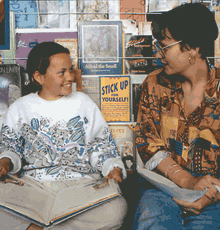 |
In
conjunction with the 2000 assessment programme in
general education, NEMP assessed a national sample
of year 8 students in Mäori Immersion education.
The results for year 8 Mäori students in immersion
education along with the results for year 8 Mäori
students in general education are given in the NEMP
report, Assessment Results for Mäori Students
2000 –
Reading and Speaking; Aspects of Technology; Music. |
IMPORTANT
NOTE RE TRANSLATION: Translations for each 'He Whakaputanga
Whakaaro' and report are historic, reflecting the
translation as at the time of printing. Variations
in translation may therefore occur from one year
to the next.
|
| HEI
WHAKATAKI 2000 |
 |
INTRODUCTION
2000 |
Koianei
ënei ko ëtahi körero e pä ana ki tëtahi
pürongo mö ngä taumata i ekea e ngä äkonga
Mäori i ngä kura rïroa, i ngä akoranga
mätauranga Mäori hoki, i a rätou e mahi ana
i ëtahi tü mahi o te National Education Monitoring
Project (NEMP) i te tau 2000. Ko te tau tuarua tënei
i uru atu ai ngä äkonga o ngä akoranga rumaki
reo Mäori ki te kaupapa o NEMP, whai muri iho o tä rätou
whakakuhuna ki te kaupapa aromatawai ä-motu i te tau
1999.
E hängai ana te pürongo a NEMP ki ngä äkonga
o te tau 8. I te tau 2000, äwhiwhiwhi e 60% o ngä äkonga
rumaki Mäori i kuraina i ngä kura rumaki. Ko te
nuinga o ngä äkonga nei i ngä Kura Kaupapa
Mäori. Ko te 40% i toe, i kuraina ki ngä kura rïroa,
engari i roto i ngä taiwhanga rumaki e akongia ana mai
i te 80 ki te 100% i roto i te reo Mäori.
I tïpako matapökerehia ngä äkonga mö te
aromatawai
ä-motu. Ko te reo Ingarihi te reo ako mö te nuinga
o ngä
äkonga e 1440 i roto i te kohinga nui. I whiriwhiria ëtahi
äkonga e 1120 e ako ana tata tonu te katoa i roto i
te reo Mäori ka mutu, kei ëtahi kura kaupapa Mäori,
taiwhanga reo Mäori ränei e akongia ana. Ka whakaritea
ngä taumata o te mätauranga i ekea e ngä töpütanga äkonga
Mäori e rua nei.
Ko te ngako o te aromatawai ä-motu nei, ko te whakaatu
he aha ngä mea ka taea e ngä äkonga, ä,
he aha ngä
mea käore e taea. He whärangi ngä huarahi
me ngä
tikanga ka mahia i roto i ngä tü mahi. I tua atu,
he teitei ake te whïwhiwhi o ëtahi tü mahi
i ëtahi, me te mea anö, ka arotahi ngä tü mahi
ki ëtahi pükenga, mätauranga mätua.
|
|
These
are comments on a report on the achievement of Mäori
students, in general and Maori-medium education, on assessment
tasks used in the National Education Monitoring Project
in 2000. It was the second year that Mäori immersion
students participated in NEMP, after being added to the
national monitoring programme in 1999.
The NEMP report focuses on year 8 students. In 2000, approximately
60 percent of Mäori immersion students were in immersion
schools. Most of these students were attending Kura Kaupapa
Maori. The other 40 percent of students attended general
education schools, but were in immersion classes which had
80 to 100 percent of instruction delivered in Maori.
Students were selected randomly for national monitoring.
English was the predominant language of instruction for the
1440 students in the main sample. A special sample of 120
year 8 students learning entirely or predominantly in Maori,
attending Mäori immersion schools or classes, was also
selected. The report compares the achievement of Mäori
students in these two samples.
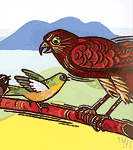 The
focus of national monitoring is to demonstrate what students
know and can do. The tasks use a wide variety of formats
and approaches. They are at various levels of complexity
and focus on a range of important skills and knowledge. The
focus of national monitoring is to demonstrate what students
know and can do. The tasks use a wide variety of formats
and approaches. They are at various levels of complexity
and focus on a range of important skills and knowledge. |
| |
|
|
TE
PÜORU
|
|
MUSIC |
Ngä
Ähuatanga Pai
I hängai ngä tü mahi puoro e 13 ki ëtahi
hätepe taketake e whä arä: te auaha puoro,
te hoki anö ki te auaha puoro kua oti kë te auaha,
te urupare ki te puoro me te märama ki te puoro. I roto
i te 77% o ngä tü
mahi nei, i örite, i pai ake ränei te mahi a ngä
äkonga rumaki Mäori (i roto i te 10 o ngä tü
mahi 13). I pai ake te mahi a ngä äkonga Mäori
kei ngä mätauranga rïroa i roto i ngä mahi
e toru o ngä mahi 13 (e 23%).
I tohu ngä tiro whänui ki ëtahi rerekëtanga
nui. Rahi ake te hou atu, rahi ake hoki te hari koa o ngä äkonga
rumaki Mäori ki te waiata i roto, i waho ake ränei
o te kura.
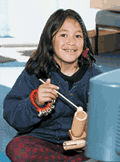
Te
Tiro Whakamua
Me whakarato rauemi, me huaki tuwheratanga mö ngä äkonga
Mäori o ngä momo whakaakoranga e rua nei, ki te
whanake i ö rätou pükenga puoro mä te:
• pänui
puoro
• märama ki te whakatakotoranga
kupu o te puoro
• whakamahi i ëtahi whakatangitangi
• auaha me te tito puoro
|
|
Good
news
The 13 music tasks addressed four fundamental processes:
creating music, re-creating music, responding to music and
understanding music. Mäori immersion students performed
comparably or better on 77 percent of the tasks (10 of 13
tasks). Mäori students in general education performed
significantly better on 23 percent of the tasks (3 of 13
tasks).
The NEMP surveys revealed some notable differences. Mäori
immersion students reported greater involvement in and enjoyment
of singing, both in and outside school. Mäori students
in general education gained more enjoyment from listening
to music in and outside school.
Looking ahead
Mäori students in both settings need resources and opportunities
to develop musical literacies through:
•
reading music
• understanding music terminology
• using a variety of musical instruments
• having opportunities to create and compose
music
|
| |
|
|
TE
HANGARAU
|
|
ASPECTS
OF TECHNOLOGY |
Ngä
Ähuatanga Pai
I mahi nui a NEMP ki te whakarato tü mahi mä ngä
äkonga mätauranga rumaki rätou ko ngä äkonga
mätauranga rïroa i roto i tënei wähanga.
I örite, i pai ake ränei te mahi a ngä äkonga
mätauranga rumaki i ngä äkonga mätauranga
rïroa i roto i te 65% o ngä tü mahi (e 11
o ngä tü mahi 17). Ko ngä tü mahi e rua
i tino pai ake ngä äkonga rumaki, ko ërä e
pä ana ki te whiriwhiri rauemi mö
tëtahi tauira ahuone, me te märama pai ki te wäriu
o ngä mea nui i roto i te ahumahi, i roto hoki i te
taiao. I roto i ngä whakaakoranga o te mätauranga
rumaki Mäori, miramirahia ai ngä kaupapa o te hangarau
ahuone me te whäwhä
ki ngä tikanga Mäori.
I pai ake te mahi a ngä äkonga Mäori i ngä mätauranga
rïroa, i ngä äkonga rumaki Mäori i roto
i ngä
tü mahi e ono. I hängai ënei tü mahi
ki te hiko, te tauira hoahoa me ngä tikanga o te taiwhanga
mahi, me kï
ko ngä wähi e tika ana mä te tohunga ki ënei
mahi e kawe. Täpiri atu me riro mai ko ngä whakaurunga
me ngä rauemi e hängai ana. Käore e kitea ëneki
tohunga, ëneki rawa i ngä whakaakoranga rumaki.
I poto ake te wä ki te whakatinana i te marautanga Hangarau,
i te wä whakatinana i te marautanga Technology. I tua
atu, käore i te taea e ngä whakaakoranga rumaki
ngä äwhina whanake ngaio me ngä rauemi e hängai
ana. Tërä pea nä
tënei ähuatanga me te kore e tino matatau o ngä kai-whakaako
ki te hangarau, kei te tömuri kë ngä äkonga
mätauranga rumaki i ngä äkonga mätauranga
rïroa i roto i tënei kaupapa ako. I tua atu he
mahi uaua te hanga kupu höu, rerenga körero hoki
mö ngä ariä
hangarau. Nä runga i te mea ko te nuinga o ngä wähi
ako reo höu kei roto kë i te kura - häunga
a waho - ka uaua rawa atu te ako kupu höu.
I tohu ngä putanga o ngä tiro whänui ki te
ngäkau nui a ngä äkonga ki te hangarau. Tata
ki te katoa o ngä
äkonga i pärekareka ki te kaupapa ako ka tahi,
ki ö
rätou pümanawa i roto i te kaupapa ka rua. I te
pätaitanga atu he ä rätou kaupapa hangarau
i te kura, ka tohu ngä
äkonga ki ëtahi wähi matua e toru. Ko ënei
ko te rorohiko, te ako ki te whäwhä rorohiko, me
te hanga räua ko te whakahoahoa. I tohu ngä äkonga
o ngä
mätauranga rïroa ki ngä kaupapa o te awheawhe
me te hanga räua ko te whakahoahoa hei kaupapa matua
i te kura. I a rätou ka whätoro atu ki ngä rorohiko,
i te nuinga o te wä mahia ai e ngä äkonga
mätauranga rïroa
ä rätou rorohiko ki te täkaro; engari anö ngä
äkonga mätauranga rumaki, mahia ai e rätou ä
rätou rorohiko ki te whakapakari ake i ö rätou
pükenga rorohiko. I tohu ngä töpütanga äkonga
nei, ko te wähi pai rawa mö te täkaro rorohiko,
kei waho o te kura. Tërä pea nä te iti noa
o ngä pümanawa rorohiko Mäori kei te wätea,
käore i rite te whakamahia o ngä rorohiko e ngä töpütanga äkonga
e rua nei.
Te Tiro
Whakamua
Me whakarato tuwheratanga ki ngä äkonga Mäori
mä
te:
• whakarongo
me te mätaki i te whänuitanga o ngä räwekeweke
puoro
• whakatakoto mahere me te whakahoahoa
• hao i ngä kupu puoro
• whitiwhiti körero mö ä rätou
mahi
Ko
te mea kë, me wätea ki ngä kai-whakaako
mätauranga rumaki ngä
huarahi whanake ngaio me ngä rauemi ki te tautoko
i tënei marautanga höu, rerekë hoki.
|
|
Good
news
NEMP had a major challenge in trying to provide feasible
tasks in both settings for the multi-disciplinary area of
technology. The Mäori students in immersion settings
performed as well as or better than the Mäori students
in general education. on 65 percent of the tasks used (11
of 17 tasks). The two tasks in which immersion pupils performed
significantly better involved selecting suitable materials
for a horticultural design brief and understanding value
positions in industry and environment. Biotechnology and
exploration of Mäori cultural norms for the environment
are emphasised in Mäori immersion education.
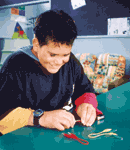 Mäori
students in general education performed significantly
better than Mäori immersion students on six
tasks. These focused on electronics, graphic design
and workshop procedures: areas that are strengthened
by specialist teaching and access to special facilities
and resources that are not widely available in immersion
settings. Implementation of the Hangarau curriculum
document has involved a more compressed timeframe
than implementation of the (English) Technology document,
with less access to professional development and
tailored resources. Limited teacher knowledge of
some aspects of technology as a result of such difficulties
could have been a contributing factor to student
achievement in this area. Also, generating Mäori
vocabulary and language structures to develop specific
technology concepts is demanding. These linguistic
complexities are compounded because the opportunity
to learn new language occurs mainly in the immersion
school setting as opposed to also having opportunities
outside of school. Mäori
students in general education performed significantly
better than Mäori immersion students on six
tasks. These focused on electronics, graphic design
and workshop procedures: areas that are strengthened
by specialist teaching and access to special facilities
and resources that are not widely available in immersion
settings. Implementation of the Hangarau curriculum
document has involved a more compressed timeframe
than implementation of the (English) Technology document,
with less access to professional development and
tailored resources. Limited teacher knowledge of
some aspects of technology as a result of such difficulties
could have been a contributing factor to student
achievement in this area. Also, generating Mäori
vocabulary and language structures to develop specific
technology concepts is demanding. These linguistic
complexities are compounded because the opportunity
to learn new language occurs mainly in the immersion
school setting as opposed to also having opportunities
outside of school.
Surveys of students’ attitudes to technology yielded
encouraging results. Almost all students enjoyed the subject
and had a positive image of their own ability. When asked
what they did in technology in school, immersion students
identified three key areas. These were computers, learning
about equipment, and making and designing. Students in general
education identified workshop subjects and making and designing
as the main areas of focus at school. When they used computers
at school, Mäori students in general education most
frequently used them for playing games, while Mäori
immersion students used them to develop computer skills.
Both groups identified playing games as most popular out
of school. Differences in the purposes for computer use in
the two groups may in part reflect the limited availability
of Mäori language software.
Looking
ahead
Mäori students need opportunities to learn by:
•
experiencing a broad range of materials and contexts
• having opportunities
to plan and design
• consolidating new technological
vocabulary
• having opportunities to discuss their work
 Immersion
educators need access to professional development and
resources to support the implementation of a relatively
new and quite different curriculum document. Immersion
educators need access to professional development and
resources to support the implementation of a relatively
new and quite different curriculum document.
|
| |
|
|
TE
PÄNUI ME TE KÖRERO
|
|
READING
AND SPEAKING |
Ngä
Ähuatanga Pai
I roto i ngä tü mahi pänui, körero e
75%, i pai ake te mahi a ngä äkonga Maori kei ngä mätauranga
rumaki Mäori, i ngä äkonga Mäori kei
ngä
mätauranga rïroa. I pai ake te mahi a ngä äkonga
Mäori kei ngä mätauranga rïroa i roto
i te 25% o ngä tü mahi (e 3 o ngä tü mahi
12). Ko tëtahi o ngä tü mahi nei, he äta
pänui, whakamäori i ëtahi tohu, ko ngä tü mahi
täpae, he pänui me te whakamärama. I whakaaturia
ko ngä pänui i te reo Ingarihi, täpaea atu
ko ngä körero o aua pänui engari i roto i
te reo Mäori, hei pänuitanga mä ngä
äkonga rumaki Mäori. Ko tëtahi ähuatanga
e pörearea ana i te whanaketanga o ngä pükenga
pänui, ko te ruarua o ngä rauemi pänui e tika
ana mö ngä
whakaakoranga rumaki, me kï i roto i te wähanga
körero pono me te wähanga mai i te tau 5 kake ake.
Rawe kë ki ngä äkonga Mäori i ngä mätauranga
rumaki te pänui i te kura. Pai ana ki a rätou te
pänui, me tä rätou whakapono he pai rätou
ki te pänui, he pai anö hoki ngä whakaaro
o ö rätou kai-whakaako,
ö rätou pakeke mö tä rätou mahi
pänui. He rerekë te titiro a ngä äkonga
Mäori i ngä
whakaakoranga rumaki Mäori he aha ia nei tënei
mea te kai-pänui pai rawa, i ngä äkonga Mäori
kei ngä
mätauranga rïroa. Ki tä ngä äkonga
Mäori i ngä mätauranga rïroa ko ngä mea
nui, ko te pärekareka i te wä e pänui ana,
kia rahi tonu ngä
mea kei te pänuitia, kia whäiti ngä mahara
ki runga i tërä e pänuitia ana. Ki tä ngä äkonga
Mäori kei ngä mätauranga rumaki Mäori,
ko te kai-pänui pai me ako i ngä kupu uaua, me
whakarongo pïkari hoki ki te kai-whakaako. Me maumahara,
käore noa iho i te tino rahi, i te kanorau ngä puka
e tika ana i roto i te reo Mäori. Ko ngä körero
e rere ana i te takiwä e mea ana nä
te iti rawa o ngä pukapuka e tika ana, ka tahuri ngä äkonga
rumaki ki te pänui i ngä tuhituhinga käore
i te tika mö rätou o tö rätou reanga.
I toko ake pea i konei ä rätou tirohanga mö te
kai-pänui pai.
Te Tiro
Whakamua
Ko tëtahi wero mä ngä kai-whakaako ko te tohu
me te whakaputa i ngä pükenga me ngä wheako
haria mai ai e ngä äkonga Mäori ki te kura.
Hei tä ngä
rangahau me ngä mätauranga whai kiko, nui te hua
ka taka ki ngä äkonga. Ko tëtahi mea anö,
he hua ka taka ki ngä äkonga Mäori i te arotahi
atu ki ngä
pükenga pëneki i te tätari me te aromatawai
pärongo hoki, ahakoa kei tëhea huara hi ako te äkonga.
E tohu ana ngä putanga, me hängai tonu te titiro
a ngä
kai-whakaako o ngä äkonga Mäori i roto i te
mätauranga rumaki räua ko te mätauranga rïroa
ki:
• ngä
körerorero o mua me te patapatai
• te whakarahi ake i te kupenga kupu, tae rawa
ki te whakamahia o ngä kupu höu
• te tätari me te tango pärongo
• te whakamahia ä-tinana nei o te mätauranga
He äwhina
nui ki te whakatüria mai ëtahi kaupapa whanake
ngaio mö
te pänui, tuhituhi, whakarongo, körero i te reo
Mäori i ngä kura rumaki përä i ngä kaupapa
whanake ngaio kei te tü mö ngä tumuaki me
ngä kai-whakaako o ngä kura rïroa.
|
|
Good
news
On 75 percent of the reading and speaking tasks, Mäori
students in Mäori immersion education performed as well
as or better than Mäori students in general education.
Mäori students in general education performed significantly
better on 25 percent of the tasks (3 of the 12 tasks). One
task required accurate reading and interpretation of signs,
and the other two were comprehension tasks. The signs were
presented in English, with accompanying Mäori translation
for Mäori immersion students. The paucity of appropriate
and relevant reading material in immersion settings, particularly
in non-fiction and from year 5 upwards, is a major hindrance
to the development of reading comprehension skills
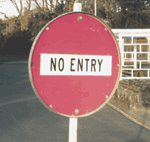 Mäori
students in immersion were more positive about reading
at school. They liked reading, believed they were
good at it, and believed that their teachers and
parents were also positive about their reading. Mäori
students in immersion programmes and Mäori students
in general education had quite different views about
what constitutes a good reader. Mäori students
in general education placed more emphasis on enjoying
books, reading a lot, and concentrating hard. Mäori
immersion students believed a good reader learned
hard words and listened to the teacher. It should
be noted that the number and variety of suitable
books in Mäori is severely limited. Anecdotal
evidence suggests that in many instances immersion
students, out of necessity, read material that is
ill suited to their age and or interest. This could
account for their views on what makes a good reader. Mäori
students in immersion were more positive about reading
at school. They liked reading, believed they were
good at it, and believed that their teachers and
parents were also positive about their reading. Mäori
students in immersion programmes and Mäori students
in general education had quite different views about
what constitutes a good reader. Mäori students
in general education placed more emphasis on enjoying
books, reading a lot, and concentrating hard. Mäori
immersion students believed a good reader learned
hard words and listened to the teacher. It should
be noted that the number and variety of suitable
books in Mäori is severely limited. Anecdotal
evidence suggests that in many instances immersion
students, out of necessity, read material that is
ill suited to their age and or interest. This could
account for their views on what makes a good reader.
Looking
ahead
An important ongoing challenge for teachers is recognising
and capitalising on the skills and experiences that Mäori
students bring to school. Research and practical experience
suggests that this can have major benefits for Mäori
students. It is also clear that Mäori students in all
settings would benefit from continual focus on skills such
as analysing and evaluating information or ideas.
Results suggest that teachers of Mäori students in Maori-medium
and general education need to continue their focus on:
•
prior discussion and questioning
• new vocabulary
• scanning and extracting information
• application of knowledge
It
would be helpful if professional development programmes
for literacy comparable to those currently available
for general education principals and teachers were made
available for immersion educators.

|
| |
|
|
TÄHÜ
KÖRERO
|
|
HISTORY |
Kei
te nohinohi tonu te mätauranga rumaki Mäori.
I waenganui i ngä
tau o te tekau tau 1980, tae rawa ki te tau 2000, me kï i
te wä i tïmataria ai ngä momo aromatawai nei,
e 59 ngä
Kura Kaupapa Mäori (KKM) i whakatüria. Kei a rätou
e kuraina ana te nui rawa atu o ngä äkonga rumaki
Mäori,
ä, i tua atu i a rätou ko ëtahi atu kura rumaki
mätauranga Mäori ruarua nei, me ngä kura rïroa
e 300 e whakarato mätauranga reo Mäori ana ki ëtahi,
ki te katoa ränei o ä rätou äkonga.
He maha, he rerekë hoki ngä kaupapa ako a ngä kura
nei, mai i ngä taiwhanga ako reo rua ka whakamahi i
ngä
kupu mämä, tae rawa ki ngä KKM e ako ana i ä rätou
äkonga i roto i te reo Mäori anake. Nä reira,
he whänui te matatau ki te reo i waenganui i ngä kai-whakaako
me ngä
äkonga kei roto i ngä tü momo whakaakoranga
nei.
Me ü ngä kura Käwanatanga me ngä kura
kömitimiti ki ngä tikanga kei te New Zealand Curriculum
Framework räua ko te National Administration Guidelines.
Me whai ngä kai-whakaako o ngä KKM i ngä here,
engari me whai anö hoki rätou i tëtahi ake
rapunga whakaaro nö rätou ake. E whakamäramahia
ana tënei i Te Aho Matua. Nö te marama o Höngongoi
o te tau 1999 whakamanatia ai a Te Aho Matua, ä, ka
noho ia hei poutokomanawa mö ngä whakahaere katoa
o te nuinga o ngä
KKM. Ka pä mai ngä here o te whakahaere taha rua
ki ngä
ärahitanga, ngä whakahaere, te tauira i te marautanga,
me te whakaratonga o ngä mahi ako. Ehara i te mea ka
pai te noho o ngä tikanga here e rua nei, nä reira
ka riro mä ngä
kai-whakaako o ngä KKM e whakariterite i ngä tauwehetanga.
He wero nui te whakarato i ngä rauemi e tika ana mä ngä
akoranga rumaki Mäori. Taketake mai te mätauranga
KKM i te ao Mäori, ä, i ngä rä o mua,
ka riro ki ngä
whänau, hapü, iwi te kawenga mö te whakarato
i ngä
rauemi tängata, taputapu hoki. Mai i ngä tau pokapü
o te tekau tau 1980 kua piki haere te rahi o ngä rauemi
kei te whakaratoa e te Käwanatanga mö te mätauranga
reo Mäori, tae rawa ki ngä KKM. Häünga
tërä, ehara i te mea ka whanatü noa he putunga
rauemi, e, me wä roa kätahi anö ka pakari
haere. Ka noho tonu te kore rauemi a te taha mätauranga
reo Mäori hei take whakatumatuma ä ngä rä kei
mua i te aroaro. Na reira, i te wä ka tätaria ngä tutukitanga
o te mätauranga reo Mäori, me aro tonu ki te mea
käore anö kia tü pakari mai te taha ki ngä rauemi
hei tautoko i a rätou kei ngä mätauranga reo
Mäori e mahi ana.
Kei te rapua tonu ngä ara e tarea ai te whakahiato i ëtahi
tikanga aromatawai mätauranga ä-motu, e aro nui
ana ki te reoruatanga me te tikanga rua, he wähanga
waiwai ënei o te mätauranga rumaki Mäori o
Aotearoa. Tërä ka noho ngä whanaketanga o
tënei wähanga hei tauira pai hei whai mä ngä äkonga
Mäori kei te mätauranga rïroa. |
|
Mäori
immersion education is still in its infancy. Between the
mid-1980s and 2000, when the assessments discussed here
took place, 59 Kura Kaupapa Mäori (KKM) schools were
established. They contain the largest proportion of Mäori
immersion students, and are complemented by a few other
Mäori immersion schools and more than 300 mainstream
schools which offer various degrees of Maori-medium education
for some or all of their students.
The programmes of these schools are many and varied. They
range from bilingual classes that use basic Mäori language
alongside a considerable amount of English to KKM, in which
Mäori is the sole medium of instruction. Consequently
there is a wide range of fluency levels in te reo Mäori
amongst staff and students in these programmes.
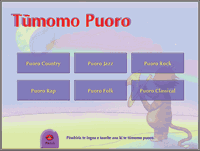 All
State and integrated schools must comply with the New
Zealand Curriculum Framework and the National Administration
Guidelines. KKM educators need to meet these requirements
but also pursue a unique philosophy of their own. This
is described in Te Aho Matua, which passed into law in
July 1999 and underpins all operations in most KKM. The
dual requirements for KKM affect governance, management,
curriculum design, and delivery. The two sets of requirements
are not always compatible, creating a tension that the
KKM staff must reconcile. All
State and integrated schools must comply with the New
Zealand Curriculum Framework and the National Administration
Guidelines. KKM educators need to meet these requirements
but also pursue a unique philosophy of their own. This
is described in Te Aho Matua, which passed into law in
July 1999 and underpins all operations in most KKM. The
dual requirements for KKM affect governance, management,
curriculum design, and delivery. The two sets of requirements
are not always compatible, creating a tension that the
KKM staff must reconcile.
Providing appropriate resources for Mäori immersion
education remain a challenge. KKM education is a Mäori
initiative, and providing human and material resources initially
was a responsibility of respective whanau, iwi, and hapu.
Government resourcing for Maori-medium education, including
KKM, has increased markedly since the mid-1980s, but it takes
considerable time and expertise to build up a resource base.
Achieving equitable resourcing for Maori-medium education
remains a challenge, and its partial state at present must
be taken into account when the accomplishments of Maori-medium
education are examined.
National education monitoring continues to explore ways to
develop appropriate 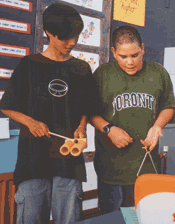 assessment
procedures that take into account the dual linguistic context
and the dual cultural context which are central to Mäori
immersion education in Aotearoa. Developments in this area
could also provide useful models for Mäori students
in general education. assessment
procedures that take into account the dual linguistic context
and the dual cultural context which are central to Mäori
immersion education in Aotearoa. Developments in this area
could also provide useful models for Mäori students
in general education. |
| |
|
|
NGÄ
MÄTÄTAKI AROMATAWAI
|
|
ASSESSMENT
CHALLENGES |
I
pau te kaha ki te whakahiato tü mahi örite
i roto i te reo Mäori me te reo Ingarihi. I whakatüria ëtahi
hui, ä, i reira whakaputaina ai e ngä kai-whakaako
rumaki Mäori ëtahi ariä mö ëtahi
tü mahi e tika ana mö ngä äkonga
i ngä whakaakoranga rumaki. I whakamahia anöhia ënei
tü mahi e ngä
äkonga i ngä whakaakoranga rïroa. Tekau örau
noa iho ënei o ngä tü mahi katoa,. Ko te nuinga
o ngä tü mahi arä, e 90% i whakahiatohia i
roto i te reo Ingarihi kätahi ka whakamäoritia.
I runga i te mea i taketake mai ngä tü mahi nei
i ngä wähi e rua, käore i tau, me te mea anö,
kaore i tarea e rätou te mahi whanake, whakaniko i ngä tü mahi
nei nä te ruarua o ngä kai-whakaako rumaki reo
Mäori e wätea ana ki te mahi i te mahi. I aromätaitia
ngä tü mahi nei e te Komiti Whakamaherehere Mätauranga
Rumaki Mäori a NEMP, rätou ko te Röpü Tohutoro
Mäori a NEMP
ä, i whakaaetia e ngä röpü e rua nei
kia whakamahia ngä tü mahi e ngä töpütanga äkonga
e rua. Engari i te tirohanga, i pai ake ngä tü mahi
ki ngä äkonga Mäori kei ngä whakaakoranga
rïroa, ki ngä äkonga Mäori e ako ana
i te reo Mäori, e whai ana hoki i te marautanga Mäori.
He mea waiwai ki te kaupapa aromatawai ä-motu te kuhuna
mai o ngä kai-whakaako rumaki Mäori ki te kaupapa
whakahiato tü mahi. He mea nui ki te rapu huarahi e
nui atu anö tä rätou whai wähi mai ki
te kaupapa. Ko te hua o tënei, ka rahi ake ngä tü mahi
e ahu mai ana i ngä kai-whakaako o ngä
KKM me ëtahi atu kai-whakaako rumaki reo Mäori.
Ka whakamahia ngä momo tü mahi nei i roto i ngä whakaakoranga
rumaki Mäori ä, i ngä wähi e tika ana,
ka whakapäkehätia hei rauemi ako i ngä äkonga
mätauranga rïroa.
I te aromatawai o te tau 1999 i puta ëtahi äwangawanga
mö ngä tü mahi i whakamäoritia. Hei tauira
atu mö tënei ähuatanga, ko te reo Mäori
i roto i ngä tü mahi, he uaua rawa mä te hunga
rangatahi, e tika ana mä ngä pakeke kë. Na
tërä ka uaua rawa atu ngä tü mahi i roto
i te reo Mäori mä
ngä äkonga. I te tau 2000 nui ngä whakarerekëtanga
e pai ake ai te whakamäori o ngä tü mahi,
kia aha, kia tata ai te rite o ngä tü mahi, taha
wetereo, taha ki te ariä hoki e whakaputaina, reo Mäori
mai, reo Ingarihi mai. He mahi nui te whakaörite i ngä tü mahi
aromatawai kei roto i ëtahi reo rerekë, ä,
ka haere tonu tënei mahi whakaörite, tätari
i ngä tü mahi.
Mö te 30% o ngä äkonga mätau-ranga rumaki,
ko te tüpuhi o ö rätou reo Mäori tëtahi
atu anö take nui i roto i te aromatawai nei. E mea ana
ngä
rangahau o te ao, me rima tau kë te äkonga e ako
ana i roto i tëtahi reo kätahi anö ka aromatawaitia
ia i roto i taua reo. Nä reira i te tau 2000 i tonoa
ngä
kura kia tïpakotia ko ërä o ä rätou äkonga
kua rima tau neke atu e whakaakongia ana i roto i te mätauranga
rumaki. Ahakoa tënei, kei te tohu ngä putanga o
ngä
tiro whänui a NEMP, i kuhu tonu mai ëtahi äkonga
tërä i pai ake pea kia aromatawaitia rätou
i roto i te reo Ingarihi.
I te tau 2000 whakatikaina ai ëtahi o ngä raruraru
i tohungia i te tau 1999. Engari kei te ü tonu kia whakatikaina
ngä
wähi kaore i te tika. Kei te äwangawanga tonu mö
te taha ki ngä pütea mä ngä whakaakoranga
rumaki Mäori, me te mea anö kia whakaarohia tënei
i te wä
ka whakamäramatia ngä putanga a NEMP. Ki te pai
te kounga me te ähua o te whakaako i te marautanga,
he whakaawe nui ënei mö ngä taumata ka kakea
e te äkonga; ka whai wähi atu anö ki tënei
ko ngä rauemi pai rawa atu ka taea e ngä äkonga.
Ko ënei katoa i runga ake nei ngä whakapänga
mai me aro i te wä pänuitia ai ngä putanga
o ngä
aromatawai a NEMP i te tau 2000. Ehara i te mea kapi katoa
ai i
ënei putanga ngä whakamärama mö ngä mea
e möhiotia nei, e tarea ai hoki e ngä äkonga
rumaki Mäori rätou ko ngä äkonga Mäori
kei ngä
kura rïroa. Ka hë te tangata ki te tahuri ia ki
te whakatakoto körero mö te pai, te kore pai ränei
o te mätauranga rumaki Mäori, o te mätauranga
rïroa hoki, i runga i ngä putanga nei. Kei te tipu
haere tonu te mätauranga rumaki Mäori, ä,
i a ia ka whanake, ka pakari haere, me tahuri tonu ki te
whakatikatika i ngä wähi e tika ana hei whakatikatika.
|
|
Every
effort was made to develop equivalent tasks in English
and Maori. Hui were held and Mäori immersion teachers
provided ideas for tasks that were appropriate for students
in immersion settings. These tasks were also used for
Mäori students in general education. Such tasks
made up about 10 percent of total tasks. The remaining
90 percent of tasks were developed in English and then
translated into Maori. Thus there was a significant imbalance
in the source of tasks used, largely because of limited
availability of Mäori immersion educators with time
to develop and refine tasks. Both the NEMP Mäori
Immersion Education Advisory Committee and the NEMP Mäori
Reference Group were involved in the evaluation of tasks
before they were administered, and approved them for
use with students in both settings. Nevertheless, the
balance of tasks probably favoured Mäori students
in general education over those learning in Mäori
from the Mäori curriculum. . The involvement of
Mäori immersion teachers in task development is
crucial to the process of national monitoring. It is
important to find ways to increase their involvement.
This would result in a higher proportion of tasks originating
from KKM and other Mäori immersion educators. These
tasks would then be used in Mäori immersion settings
and, where appropriate, translated for use with students
in general education.
In the 1999 assessments there were a number of concerns about
the translations. For example, the Mäori versions often
used language that was more suited to adults than students,
making the tasks more difficult in Maori. In 2000 major changes
were made to improve the translations and hence the equivalence
of the tasks, linguistically and conceptually, in the two
languages. Achieving equivalence of assessment tasks in different
languages is very demanding and this aspect of these assessments
will need ongoing effort and scrutiny.
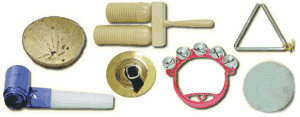
Limited
student understanding of te reo Mäori was another
major issue in 1999 for the assessments of about 30 percent
of the immersion students. International research suggests
that students should have at least five years of immersion
in a language before assessment in that language is undertaken.
In 2000, therefore, schools were asked to select only
those students who had at least five years in immersion
education. Despite this, NEMP survey results indicated
that there were still some students who thought they
would have done better if they had been assessed in English.
A number of concerns that were identified in 1999 have
been addressed in 2000. However, there is still substantial
scope for improvements, and a commitment to work on these.
Issues of comparable resourcing for Mäori immersion
programmes continue to cause concern, and must be taken
into account when interpreting the NEMP results. Student
achievement is influenced and shaped by the quality and
style of curriculum delivery; and implicit in this is access
to quality resources.
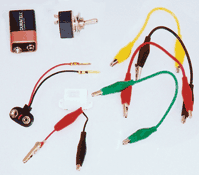 It
is within this context that readers should consider
the results generated from assessment in NEMP 2000.
These results do not claim to explore the full extent
of what students in Mäori immersion know and
can do nor what Mäori students in mainstream
schools know and can do. It would be most unwise
to draw conclusions about the merits of Mäori
immersion education or general education based on
these results. Mäori immersion education continues
to be an emerging field but as it grows and consolidates
further improvements should be achieved. It
is within this context that readers should consider
the results generated from assessment in NEMP 2000.
These results do not claim to explore the full extent
of what students in Mäori immersion know and
can do nor what Mäori students in mainstream
schools know and can do. It would be most unwise
to draw conclusions about the merits of Mäori
immersion education or general education based on
these results. Mäori immersion education continues
to be an emerging field but as it grows and consolidates
further improvements should be achieved. |
| |
|
|
WHAKATAU
|
|
CONCLUSION |
He wähi
höu i tïmataria i te tau 1999 tënei te aroturuki
i ngä äkonga Mäori rumaki reo. Iti noa ngä körero
mö ngä huarahi mahi pai rawa e tika ana i Aotearoa,
me te mea anö, ehara i te mea he ngäwari ngä wähanga
o te take nei. I runga i tërä, ko te mahi nui
mä NEMP i roto i te take nei, e hängai ana ki
te whakahiato me te rapu he aha ngä tikanga aroturuki
e tika ana. Ahakoa ngä tini putanga këtanga i
roto i te wä, ka noho ënei mahi hei papa mö ngä rä kei
te tü. Ko te wero ki a NEMP kia whakahiatohia mai ëtahi
tü mahi e hängai ana, e whakamahi ana i te tuhituhinga
Mäori tüturu me te tikanga Mäori, hei whakaata
i ngä wheako o ënei äkonga.
E mau pü ana te körero, ko NEMP kei mua e haere
ana i roto i te rangahau ko ëhea ngä huarahi mahi
tika, e taea ai ngä
körero e pä ana ki ngä taumata e ekea ana
e te Mäori i roto i ngä kaupapa mätauranga. |
|
Assessment
of the achievements of students in Mäori immersion
education, begun in 1999, is an emerging field of investigation.
Little information exists on best practice appropriate
for New Zealand, and essential considerations are not uncomplicated.
As a result, the first attempts of NEMP have been largely
concerned with developing and exploring suitable assessment
procedures. Although there have been significant difficulties,
it provides a valuable basis for future work. The challenge
for NEMP is to develop appropriate tasks using both authentic
Mäori text and cultural practices reflecting the experiences
of these students.
The forum recognises that the National Education Monitoring
Project leads the way in developing approaches intended to
provide detailed and helpful information on Mäori achievement
in education. |
|
 |
|
|